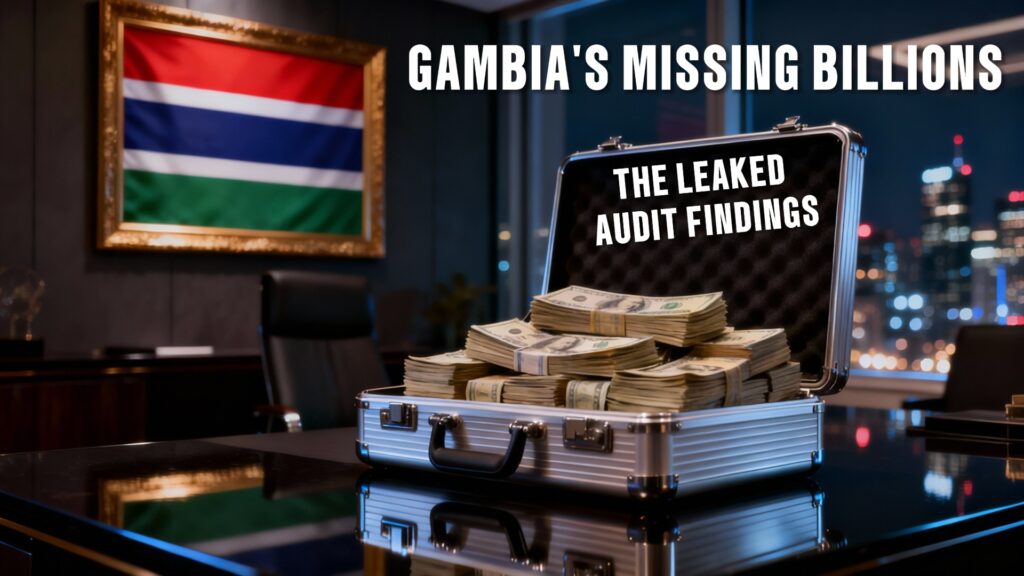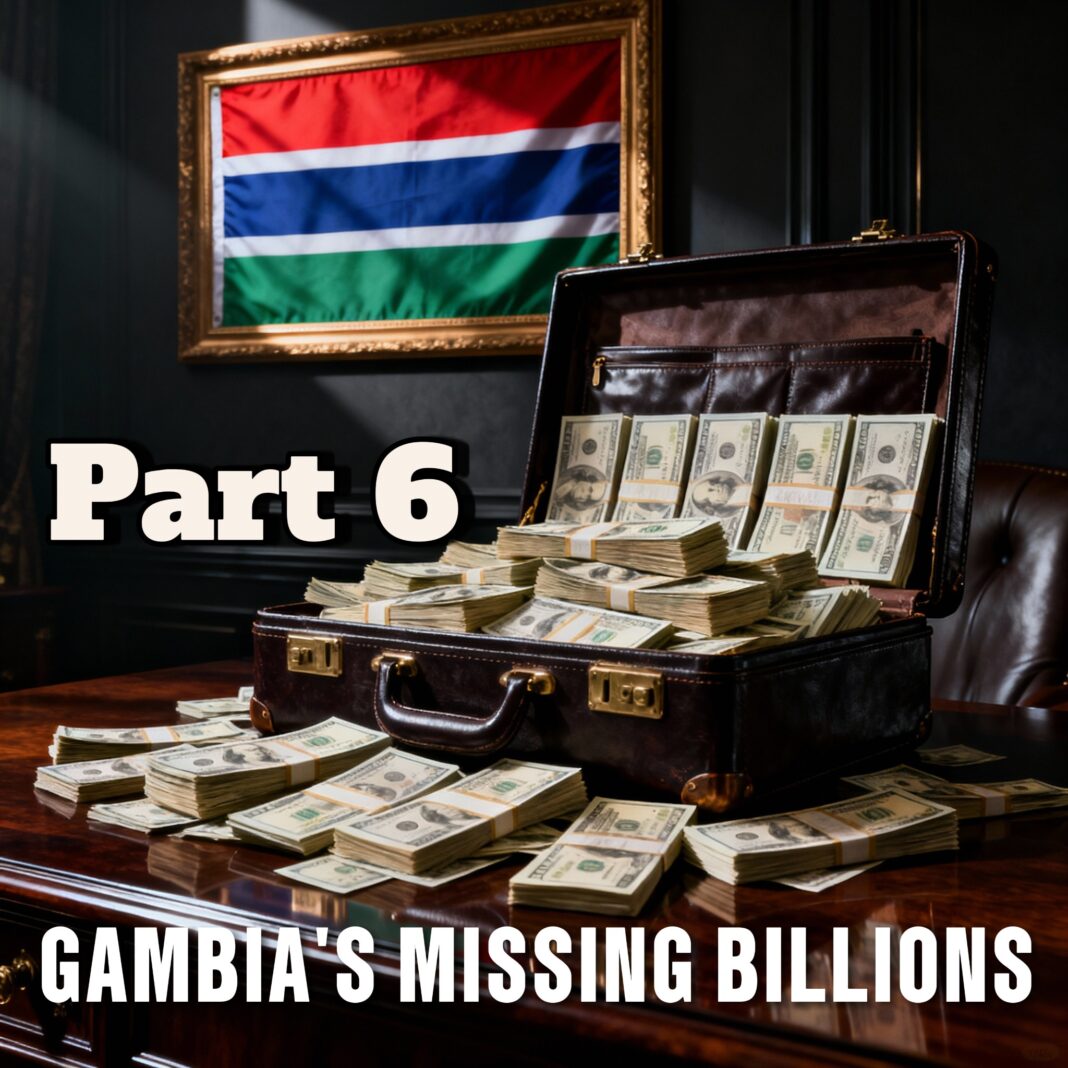
Most Gambians think “government money” means taxes. But there’s another stream, non-tax revenue, the cash you pay at passport counters, courts, land offices, fisheries, telecom licensing, customs processing, bridge tolls, etc. It’s supposed to end up in the same public pot.
For three straight years, the Auditor General made this the top red flag (a Key Audit Matter) because 11 institutions outside GRA collect it, and the controls are weak. The government’s own books say non-tax revenue totalled D3.923 bn (2021), D2.388 bn (2022), and D4.408 bn (2023).
The plain-language problem: for every dalasi, you should see (1) a receipt number → (2) a bank slip → (3) a Treasury posting. When those links break, money can vanish.
Headline numbers (from the Government’s own statements)
• 2023: D4,407,758,000 non-tax revenue.
• 2022: D2,387,998,000 non-tax revenue.
• 2021: D3,922,841,000 non-tax revenue.
The Auditor General kept the same Key Audit Matter all three years: non-tax revenue collected by 11 ministries/departments, including amounts by the Geology Department (heavy minerals/black sand).
2021 — What made up the D3.923 bn?
From the detailed schedule for 2021:
• Petroleum Importation Licenses: D1,803,150,000
• Customs Processing Fees: D598,473,619
• GSM/VSAT License: D182,758,439
• International Gateway: D78,554,531
• Road Tax: D46,272,231
• Passport Fees: D41,651,716
• Aliens’ ID Cards: D33,528,376
• Sales of National ID Cards: D21,922,510
• Car-park Fees (Area Councils): D30,866,304
(Extracts from the 2021 schedule.)
Why this year matters: the AG flags non-tax revenue as a KAM and cites Jammeh asset sales (D277.966 m) and Geology heavy-mineral accounts (D76.150 m) inside the non-tax total. He also warns that D79.212 m in quarry royalties and D8.691 m in illegal-fishing charges were not recognised, i.e., the non-tax total was understated.
2022 — What made up the D2.388 bn?
The 2022 statements still show detailed lines (and 2021 as comparatives). Key items that recur across the period:
• Customs Processing Fees: D598,473,619 (2021 comparative; still a significant line in 2022).
• GSM/VSAT License: D182,758,439 (2021 comparative; similar scale in 2022).
• International Gateway: D2,194,693 in 2022 (collapsed from 2021).
• Car-park fees (Area Councils): D30,866,304 (prior year comparative used in 2022 schedules).
Significant 2022 shift: the AG’s KAM now also singles out contingent liabilities (government court cases and guaranteed loans) at D2.790 bn, showing how potential payouts could hit the budget.
2023 — What made up the D4.408 bn?
In 2023, the notes show less item-by-item detail and more category totals:
• Sales of goods & services (Note 6B): D3,132,053,340
• of which Administration fees/licences/permits/registrations: D2,156,780,330
• Sales by market establishments: D927,467,870
• Car-park fees: D36,511,680
• Incidental sales (non-market): D11,293,470
• Property income (Note 6A): D92,232,850 (rents etc.).
• Fines & penalties (Note 6C): D1,908,500.
I do get a helpful 2023 code-level list for some items:
• Customs processing fees (2023): D652,648,447
• GSM License/VSAT (2023): D205,153,652
• International Gateway (2023): D6,191,754
• Passport fees (2023): D125,678,430
• Aliens’ ID cards (2023): D51,135,640
• Sales of National ID (2023): D21,516,840
• Road Tax (2023): D54,667,098
What changed and by how much? (Selected lines)
I compare 2023 to 2021 on the lines we can see clearly in both detailed lists:
• Customs processing fees: D598.47 m → D652.65 m (+9.1%).
• GSM/VSAT licence: D182.76 m → D205.15 m (+12.3%).
• International Gateway: D78.55 m → D2.19 m → D6.19 m (–97.2% in 2022; partial rebound +182% in 2023).
• Passport fees: D41.65 m → D125.68 m (+201.7%).
• Aliens’ ID cards: D33.53 m → D51.14 m (+52.5%).
• Sales of National ID cards: D21.92 m → D21.52 m (–1.9%).
• Road tax: D46.27 m → D54.67 m (+18.1%).
• Car-park fees (Area Councils): D30.87 m → D36.51 m (+18.3%).
Category jumps in 2023 (vs 2022):
• Administration fees/licences/permits: D1.946 bn → D2.157 bn (+10.8%).
• “Sales by market establishments”: D8.186 m → D927.468 m (+11,229%). This 100× explosion requires receipts → bank slips → Treasury postings.
The “mystery lines” citizens should question
• Petroleum Importation Licences: D1.803 bn in 2021, then effectively zeroed later (2023 shows “—” on this line). If that’s a policy/legal change, where’s the circular? If it were re-coded, to which line? If foregone, who approved?
• International Gateway: D78.55 m (2021) → D2.19 m (2022) → D6.19 m (2023). A 97% collapse is not a normal fluctuation. Was there a tariff cut, outsourcing, or waiver? Table the contract and bank lodgements.
• Recoveries (Jammeh/Janneh): Explicit in 2021 (D277.966 m) but invisible in the 2023 notes provided. If recoveries continued, where were they posted? If they ceased, why?
Why the Auditor General kept this as a Key Audit Matter
Because 11 institutions collect this money outside the core GRA pipeline, multiple hands, uneven controls, and big totals. In 2023, the AG again highlights: “non-tax revenue … collected by eleven (11) institutions … total GMD 4,407,575,290 (of which GMD 26,878,620 by Geology/Heavy Minerals).”
And the Management Letters deepen the concern:
• Auditors denied system access at GRA (ASYCUDA, GAMTAXNET, Nick TC-Scan). Your numbers aren’t verifiable if the auditor can’t see the live systems.
• Wrong FX (foreign exchange)rates used at GRA led to a D96,112,060 loss. If customs values are off, non-tax and tax streams are both wrong.
• Cuban doctors’ cash handling (2021): 151 doctors paid USD 120,800 in cash each month via vouchers, classic fraud risk in a cash-heavy area.
What does this mean in everyday language
Think of every dalasi like a traveller. It should leave three footprints:
1. Receipt number (pre-numbered, no gaps),
2. Bank slip (same-day deposit),
3. Treasury posting (IFMIS entry to the Consolidated Fund).
When we see giant swings, like “market sales” jumping from D8 m to D927 m in one year, without an official explanation and those three footprints, citizens must assume leakage until proven otherwise.
What FPAC and citizens must demand (documents, not speeches)
• The policy memo/contract explaining the collapse of Petroleum Import Licences after 2021 and the International Gateway collapse in 2022, attach bank statements and IFMIS postings for the last month before the change.
• A quarter-by-quarter ledger for the 2023 “market establishments” D927 m, who paid, what service, which receipt series, which bank account, what Treasury posting.
• System access for the auditor to ASYCUDA, GAMTAXNET, and Nick TC-Scan. Without access, the numbers are not audit-quality.
• The 2021–2023 recoveries (Jammeh/Janneh) bank statements and CRF postings; if recoveries stopped, the cabinet/ministerial note that says so.
The moral bottom line
This isn’t bookkeeping. It’s rice on the table and medicines on the shelf. When one line can swing hundreds of millions without a public explanation and without those three proofs, that’s not budgeting, that’s blindfolding the nation.
Close the side doors. Force every dalasi to leave a receipt, a bank slip, and a Treasury posting that the public can see.
By Jallow Modou, Washington D.C, USA- Financial Analyst

